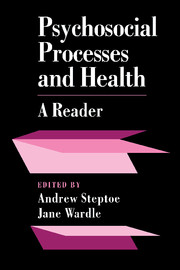Book contents
- Frontmatter
- Contents
- Preface
- Section 1 Life stress, social support and health
- Section 2 Psychophysiological processes in disease
- Pain mechanisms: a new theory
- Effects of coping behavior on gastric lesions in rats as a function of the complexity of coping tasks
- Social stress and atherosclerosis in normocholesterolemic monkeys
- Mental stress and the induction of silent myocardial ischemia in patients with coronary artery disease
- Depressed lymphocyte function after bereavement
- Psychological stress and susceptibility to the common cold
- Section 3 Personality, behaviour patterns and health
- Section 4 Health practices and the modification of health risk behaviour
- Section 5 Coping with illness and disability
- Section 6 Behavioural interventions in medicine
- Index
Mental stress and the induction of silent myocardial ischemia in patients with coronary artery disease
from Section 2 - Psychophysiological processes in disease
Published online by Cambridge University Press: 05 August 2016
- Frontmatter
- Contents
- Preface
- Section 1 Life stress, social support and health
- Section 2 Psychophysiological processes in disease
- Pain mechanisms: a new theory
- Effects of coping behavior on gastric lesions in rats as a function of the complexity of coping tasks
- Social stress and atherosclerosis in normocholesterolemic monkeys
- Mental stress and the induction of silent myocardial ischemia in patients with coronary artery disease
- Depressed lymphocyte function after bereavement
- Psychological stress and susceptibility to the common cold
- Section 3 Personality, behaviour patterns and health
- Section 4 Health practices and the modification of health risk behaviour
- Section 5 Coping with illness and disability
- Section 6 Behavioural interventions in medicine
- Index
Summary
Abstract
To assess the causal relation between acute mental stress and myocardial ischemia, we evaluated cardiac function in selected patients during a series of mental tasks (arithmetic, the Stroop color-word task, simulated public speaking, and reading) and compared the responses with those induced by exercise. Thirty-nine patients with coronary artery disease and 12 controls were studied by radionuclide ventriculography.
Of the patients with coronary artery disease, 23 (59 percent) had wall-motion abnormalities during periods of mental stress and 14 (36 percent) had a fall in ejection fraction of more than 5 percentage points. Ischemia induced by mental stress was symptomatically “silent” in 19 of the 23 patients with wall-motion abnormalities (83 percent) and occurred at lower heart rates than exerciseinduced ischemia (P<0.05). In contrast, we observed comparable elevations in arterial pressure during ischemia induced by mental stress and ischemia induced by exercise. A personally relevant, emotionally arousing speaking task induced more frequent and greater regional wall-motion abnormalities than did less specific cognitive tasks causing mental stress (P < 0.05). The magnitude of cardiac dysfunction induced by the speaking task was similar to that induced by exercise.
Personally relevant mental stress may be an important precipitant of myocardial ischemia - often silent - in patients with coronary artery disease. Further examination of the pathophysiologic mechanisms responsible for myocardial ischemia induced by mental stress could have important implications for the treatment of transient myocardial ischemia. (N Engl J Med 1988; 318:1005-12.)
Recent research indicates that transient myocardial ischemia is common in patients with coronary artery disease. It usually occurs without symptoms, at low heart rates, and has a circadian rhythm that parallels changes in heart rate, blood, pressure, and the release of catecholamines. Other evidence suggests that mental stress - like physical stress - may be associated with myocardial ischemia. It is currently unknown whether ischemia is a direct consequence of mental activities or a spontaneous or independent phenomenon. Laboratory studies involving the provocation of myocardial ischemia by mental stress are needed to confirm such a causal relation.
Studies involving positron-emission tomography have demonstrated that a wide variety of physiologic stimuli, including physical exercise, exposure to cold temperature, smoking, and nonspecific forms of mental stress, can induce transient ischemia in selected patients with coronary artery disease.
- Type
- Chapter
- Information
- Psychosocial Processes and HealthA Reader, pp. 147 - 165Publisher: Cambridge University PressPrint publication year: 1994



